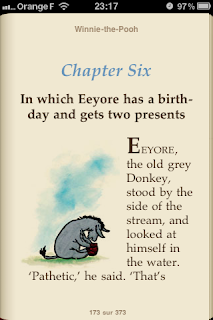Ebooks are here to last, I think that is an undisputable fact. But how would you define what an ebook is?
The usual definition says that it is a book in digital form, readable on digital devices. I am not comfortable with this definition.
Almost any displayable text-based file on my computer, providing it has a minimum length that matches what we think of a book, would fit this definition: it is a book, and it is readable on a digital device.
As a matter of fact, I have read whole books on screen that were actually plain text files. The first one I remember reading was Alice in Wonderland in the mid-nineties (and, yes, I was more than 25 years old by then...)
We can also argue that any word processor file can be considered as an ebook: I can write, distribute and then read any book in a Word or OpenOffice Writer file (or any other word processor, for that matter).
Last, it is quite common to find books in PDF. Many publishers propose ebooks in this format.
Anyhow, I think this definition does not fit the practices. Now, when you talk about ebooks, you have in mind the reading ecosystem, be it specialized devices, such as the Amazon Kindle, or applications running on general-purpose devices, such as all the Amazon Kindle applications, or Apple iBooks on the iPhone and the iPad.
What matters most, now, is the comfort of reading, more than the digital form factor. You can read a PDF or a Word document on an iPhone, but it simply isn't comfortable: the text doesn't fit the screen, the fonts are ridiculously small, and the screen space is clogged up with the page header and footer. Some applications do a bit better, but it is more convenient than pleasant.
This simply is because PDF and the word processors are rooted in the WYSIWYG: What You See (on the screen) Is What You Get (on the printer). The overall goal was to present the exact layout you will get when printing; then, it is your problem to have a letter or A4-sized screen.
So, I would tend to say that an ebook is a book in digital form, that, ideally, does not contain layout information. This lack of layout information lets you fit the text, and the images, to whatever screen space is available.
That is exactly the philosophy behind the mobi file format, that is used in the Kindle ecosystem, and the EPUB file format, that is used in the iBooks ecosystem: they only contain the bare text, and its logical structure (chapters, paragraphs, page breaks and so on), and let the device fit the text on the screen. They can also handle text formatting when needed, for instance when displaying poetry.
The only caveat is with highly visual books, such as art books. In this case, the layout is part of the "data" of the ebook. Simple cases, such as illustrated books, can be handled with EPUB. Have a look at Winnie-the-Pooh on iBooks (it's free): the images are basically in place, matching the neighboring text.
It is an entirely different story when the image position, respective to the text and to one another, have a meaning. I am not even sure this has been actually tried in actual ebooks. How would the book on the photo above fit in an ebook (Michel-Ange, l'oeuvre complète [Michelangelo, Comprehensive Works], by F. Zöllner, C. Thoenes and T. Pöpper)? It even has a centerfold of the Sixtine Chapel! But, with its 716 pages and its weight of about 10 Kilograms, I would welcome a digital version from time to time...
As you can see, I am not totally satisfied. What is your opinion?

